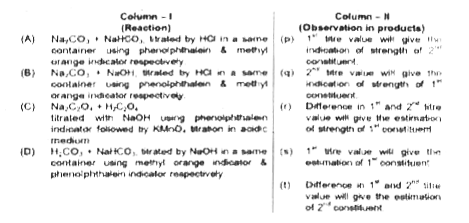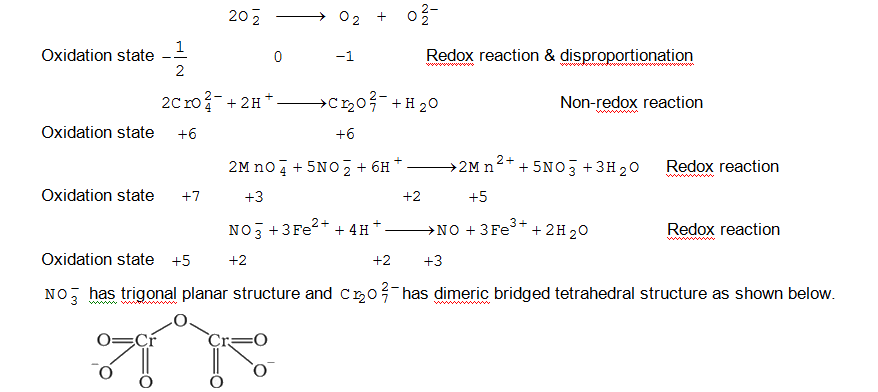Match the reactions in column I with nature of the reaction/type of the products in column II. 

Similar Questions
Knowledge Check
Match the reactions in Column I with nature of the reactions/type of the products in Column II
 AABCD21,434BABCD1,431,21CABCD2314DABCD342,31
AABCD21,434BABCD1,431,21CABCD2314DABCD342,31Match the reactions in Column I with nature of the reactions / type of the products in Column II
AColumn IColumn II(A)O−2→O2+O2−2(P)Redox reactionBColumn IColumn II(B)CrO2−4+H+→(Q)One of the products has trigonal planar structureCColumn IColumn II(C)MnO−4+NO_2+H+→(R)dimeric bridged tetrahedral metal ionDColumn IColumn II(D)NO−3+H2SO4+Fe2+→(S) disproportionationMatch the reactions in Column I with nature of the reactions / type of the products in Column II.
 AAgNO3(aq)+I2(excess)+H2O→ (p)DisproportionationBK2MnO4(aq)+CO2(g)→ (p)ComproportionationCNa2Cr2O7+CΔ−−→ (r)Redox reactionDCuCl2(aq)+Cu(s)→ (s)One of the products is insoluble in water
AAgNO3(aq)+I2(excess)+H2O→ (p)DisproportionationBK2MnO4(aq)+CO2(g)→ (p)ComproportionationCNa2Cr2O7+CΔ−−→ (r)Redox reactionDCuCl2(aq)+Cu(s)→ (s)One of the products is insoluble in water
The section contains one question. Each question contains statements given in two columns which have to be matched . The statements in Column I are labelled A, B, C and D , while the statements in Column II are labelled p,q, r, s and t. Any given statement in Column I can have correct matching with ONE OR MORE statements (s) in Column II . The appropriate bubbles corresponding to the answers to these questions have to be darkened as illustrated in the following example:
If the correct matches are A-p, s and t, B-q and r, C-p and q, and D-s and t, then the correct darkening of bubbles will look like the following .

Match the reactions in Column I with nature of the reactions/type of the products in Column II. Indicate your answer by darkening the appropriate bubbles of the 4×4 matrix given in the ORS.

View SolutionMatch the reaction in Column I with nature of the reactions/type of the products in Column II.
Column IColumn II(A)AgNO3(aq)+I2(s)(excess)+H2O(l)→(p)Redox reaction(B)CrO2−4(aq)+H+(aq)→(q)One of the products has trigonal planar structure(C)MnO−4(aq)+NO−2(aq)+H+(aq)→(r)Dimeric bridged tetrahedral metal ion(D)NO−3(aq)+H2SO4(aq)+Fe2+(aq)→(s)Disproportionation(t)Colour of one of the products is due to charge transfer spectrum
View SolutionMatch the reactions in Column I with nature of the reactions / type of the products in Column II.


View SolutionMatch the reactions in Column I with nature of the reactions / type of the products in Column II.


View SolutionMatch the reactions in Column I with nature of the reactions / type of the products in Column II.

View Solution


 .
.